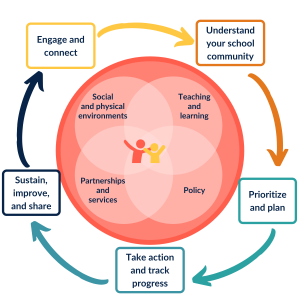Comprehensive School Health
Using a Comprehensive School Health Approach
A healthy school community supports the wellness of all its members (students, teachers, staff and parents). The comprehensive school health (CSH) framework is Alberta’s roadmap for school health. It’s often referred to as a whole school approach because it touches on all aspects of school life.
CSH has been used for generations to guide school health in a way that’s coordinated and reinforcing. It goes beyond one-time activities like wellness fairs or invited speakers, and helps to focus on improvements that are meaningful, effective, and likely to last. The resources on this website are meant to support teachers, students, school administrators, school jurisdiction staff, health professionals, parents and community members in building healthy school communities.
The comprehensive school health framework prioritizes school wellness across four components:
- Social and physical environments
- Teaching and learning
- Policy
- Partnerships and services
For more information on CSH framework and actionable ways to incorporate it within your classroom and school, visit Healthier Together Schools

The suggestions below are specific to supporting sexual health education and inclusivity in both your classroom and the broader school environment.
Social and physical environments
Social environments shape how students feel at school. They include:
- Positive relationships between students, their peers, school staff and the school community stakeholders (including virtual relationships)
- Support the development of peer support or inclusion groups such as Gender-Sexuality Alliances (GSAs) or Queer-Straight Alliances (QSAs)
- Ask students what their pronouns and preferred name is and honour their choice
- Ways of welcoming and including all students within a classroom or learning cohort, and promoting belonging
- Use inclusive language within the classroom and school
- Show that you welcome students of all sexual orientations, gender identities and gender expressions by displaying pride flags or safe space stickers
- Recognize and respond to witnessed and/or reports of sexual and gender-based bullying, harassment and violence
- Opportunities for students to be full and equal partners in decision-making about their school experience
Physical environments are spaces for learning, movement and play. They include:
- Indoor spaces like classrooms, hallways, gymnasiums, cafeterias, and learning commons
- Assign a gender neutral washroom(s) for students and staff
- Outdoor spaces like playgrounds, fields, outdoor classrooms, gardens, and pathways
- Equipment and materials like furniture, kitchen appliances, lighting, and ventilation
Teaching and learning
Teaching and learning involves the ways that both students and staff learn and practice health at school. It includes:
- Curriculum-based instruction and activities to develop, strengthen, and practice skills (including both in-person and virtual teaching)
- Actively incorporate sexual and gender diversity throughout all curricula
- For example, in language arts, share a story with students that includes a 2SLGBTQI+ family
- Actively incorporate sexual and gender diversity throughout all curricula
- Informal instruction that happens outside of traditional learning spaces, like through online social experiences, hallway or recess conversations, or extracurricular activities
- Model welcoming and inclusive language and behaviour for students to observe and follow
- Training for pre-service teachers and ongoing professional learning for school staff, including virtual and in-person workshops, presentations, webinars, mentorships, and collaboratives
- Think about holding a ‘lunch and learn’ for staff who feel they want to expand their knowledge about Sexual Orientation and Gender Identity and Expression (SOGIE) topics, language and inclusivity strategies
Policy
Policies are written directives that influence school life. They include:
- Policies and standards set by Alberta Education, like the Daily Physical Activity Policy, Human Sexuality Education Policy, and Ministerial Order on Student Learning
- Familiarize yourself and ensure you are following the Safe and Caring Schools legislation within the Education Act
- Board policies, administrative procedures, and regulations set by school authorities
- Multi-year education plans or frameworks developed by school authorities
- Annual development plans in schools
- Student codes of conduct
- Create and follow school policies and student codes of conduct regarding sexual and gender diversity
Partnerships and services
Partnerships are connections and relationships between schools and communities, like:
- Parents, caregivers, and other family members
- Community organizations and groups
- Elders and other community champions
- Local facilities like recreation centres, libraries, and parks
Services are supports offered by health professionals or social service providers in collaboration with schools, like:
- Immunization programs for students
- Public health inspections
- Teacher training in school health promotion
- School health information, resources, and coaching
- Consider inviting school-approved community partners to present on SOGIE topics to create a culture of inclusivity